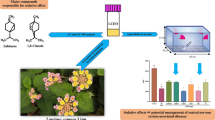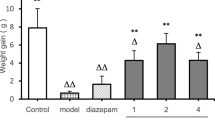Abstract
This study investigated the stimulative or sedative effects of inhaling fragrant essential oils (EOs) by using a forced swimming test (FST) with mice. This behavioral test is commonly used to measure the effects of antidepressant drugs. The inhalation by mice of EOs, such as ginger oil (p<0.05), thyme oil (p<0.05), peppermint oil (p<0.05), and cypress oil (pš0.01) resulted in 5% to 22% reduction of immobility. The same results were achieved when over-agitation was artificially induced in the mice by an intraperitoneal injection of caffeine (a psycho-stimulant). In contrast, inhalation of some EOs by the mice resulted in increased immobility. To evaluate more correctly the sedative effects of EOs, the immobility of over-agitated mice induced with caffeine was ascertained after the inhalation of various EOs. Inhalation of lavender oil (p<0.01) and hyssop oil (p<0.01) increased the immobile state in mice that were treated with caffeine. The results of this study indicate that the inhalation of essential oils may induced stimulative or sedative effects in mice.
Similar content being viewed by others
References
Buchbauer, G., Jirovetz, L., Jager, W., Plank C., and Dietrich, H., Fragrance compounds and essential oils with sedative effects upon inhalation.J. Pham. Sci., 82(6), 660–664 (1993).
Haze, S., Sakai, K, and Gozu, Y., Effects of fragrance inhalation on sympathetic activity in normal adults.Jpn. J. Pharmacol., 90, 247–253 (2002).
Kagawa, D., Jokura, H., Ochiai, R., Tokimitsu, I., and Tsubone, H., The sedative effects and mechanism of action of cedrol inhalation with behavioral pharmacological evaluation.Planta Med., 69, 637–641 (2003).
Kovar, KA., Gropper, B., Friess, D., and Ammon, HPT., Blood levels of 1,8-cineol and locomotor activity of mice after inhalation and oral administration of rosemary oil.Planta Med., 53, 315–318 (1987).
Kuribara, H., Caffeine enhances the stimulant effect of methamphetamine, but may not affect induction of methamphetamine sensitization of ambulation in mice.Psychopharmacology 116, 125–129 (1994).
Lorig, TS., and Schwarts, GE., Brain and Odor: I. Alteration of human EEG by odor administration.Psychobiology, 16, 281–284 (1988).
Lucki, I., Dalvi, A., and Mayorga, AJ., Sensitivity to the effects of pharmacologically selective antidepressants in different strains of mice.Psychophamacology, 155, 315–322 (20010.
Manley, CH, Pshchophysiological effect of odor.Crit. Rev. Food Sci., 33, 57–62 (1993).
Porsolt, RD., Bertin, A., and Jalfre, M., Behavioural despair in mice: A primary screening test for antidepressants.Arch. Int. Pharmacodyn. Ther., 229, 327–336 (1997a).
Porsolt, R.D., LePichon, M., and Jalfre, M., Depression: A new animal model sensitive to antidepressant treatments.Nature, 266, 730–732 (1997b).
Redrobe, J. P. and Bourin, M., Dose-dependant influence of buspirone on the activities of selective serotonin reuptake inhibitors in the mouse forced swimming test.Psychophamacology, 138, 198–206 (1998).
Tisserand, R., The art of aromatherapy Essex, Daniel, C.W., UK (1993).
Tsuchiya, T., Tanida, M., Uenoyama, S., Nakayama, Y., and Ozawa, T., Effects of olfactory stimulation on the sleep time induced by pentobarbital administration in mice.Brain Research Bull. 26, 397–401 (1991).
Umezu, T., Behavioral effects of plant-derived essential oils in the Geller type conflict test in mice.Jpn. J. Pharmacol., 83, 150–153 (2000).
Umezu, T., Sakata, A., and Ito, H., Ambulation-promoting effect of peppermint oil and identification of its active constituents.Phamacol. Biochem. Be., 69, 383–390 (2001).
Author information
Authors and Affiliations
Corresponding author
Rights and permissions
About this article
Cite this article
Lim, W.C., Seo, J.M., Lee, C.I. et al. Stimulative and sedative effects of essential oils upon inhalation in mice. Arch Pharm Res 28, 770–774 (2005). https://doi.org/10.1007/BF02977341
Received:
Issue Date:
DOI: https://doi.org/10.1007/BF02977341




